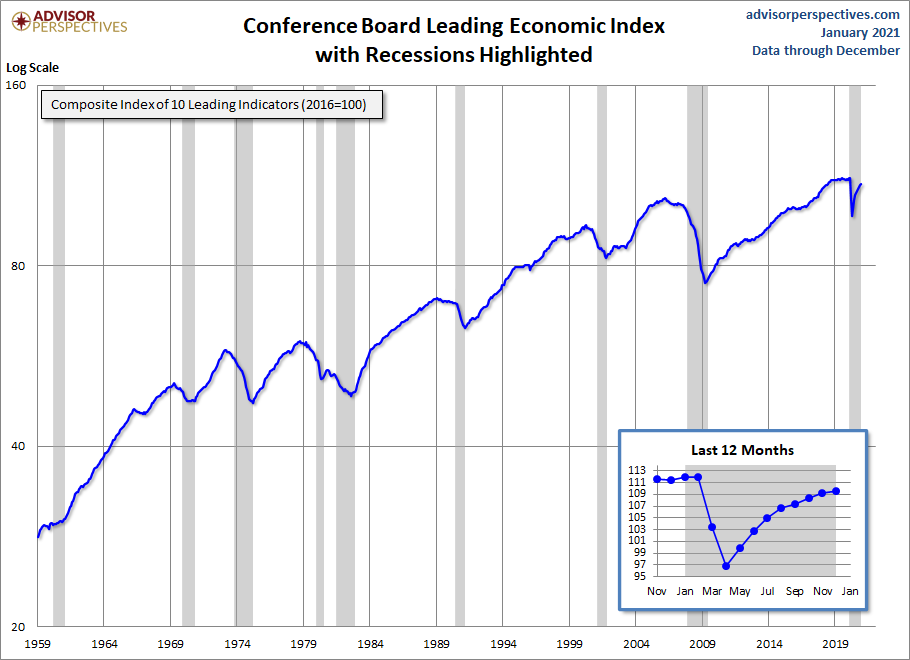CB Leading Economic Index: LEI And CEI Up Again In December, Annual Revisions
The latest Conference Board Leading Economic Index (LEI) for December was up 0.3% from the November final figure of 109.2. Annual revisions were made.
Here's an excerpt from the technical notes.
The Conference Board LEI for the U.S. increased slightly in December. Positive contributions from the ISM® New Orders Index, stock prices, and building permits more than offset the large negative contribution from average weekly initial claims for unemployment insurance (inverted). Over the second half of 2020, the leading economic index increased 6.5 percent (about a 13.5 percent annual rate), a reversal from its negative growth of 7.7 percent (about a -14.8 percent annual rate) during the first half of 2020. In addition, the strengths among the leading indicators remain very widespread.
The Conference Board CEI for the U.S., a measure of current economic activity, also increased in December. The coincident economic index rose 4.4 percent (about a 9.1 percent annual rate) between June and December 2020, a reversal from its decline of 7.5 percent (about a -14.4 percent annual rate) over the previous six months. Additionally, the strengths among the coincident indicators have remained very widespread, with all components advancing over the past six months. The lagging economic index continued to increase, but at a slower rate than the CEI. As a result, the coincident-to-lagging ratio increased slightly. Real GDP expanded at a 4.0 percent annual rate in the last quarter of 2020, after increasing 33.4 percent (annual rate) in the third quarter.
Here is a log-scale chart of the LEI series with documented recessions as identified by the NBER. The use of a log scale gives us a better sense of the relative sizes of peaks and troughs than a more conventional linear scale.

For additional perspective on this indicator, see the latest press release, which includes this overview:
This month's release incorporates annual benchmark revisions to the composite economic indexes, which bring them up-to-date with revisions in the source data. These revisions do not change the cyclical properties of the indexes. The indexes are updated throughout the year, but only for the previous six months. Data revisions that fall outside of the moving six-month window are not incorporated until the benchmark revision is made and the
entire histories of the indexes are recomputed. As a result, the revised indexes, in levels and month-on-month changes, will not be directly comparable to those issued prior to the benchmark revision.“The US LEI’s slowing pace of increase in December suggests that US economic growth continues to moderate in the first quarter of 2021. Improvements in the US LEI were very broad-based among the leading indicators, except for rising initial claims for unemployment insurance and a mixed consumer outlook on business and economic conditions,” said Ataman Ozyildirim, Senior Director of Economic Research at The Conference Board. “While the resurgence of COVID-19 and weak labor markets remain barriers to growth, The Conference Board expects the economy to expand by at least 2.0 percent (annual rate) in Q1 and then gain momentum throughout the year.”
For a better understanding of the relationship between the LEI and recessions, the next chart shows the percentage-off the previous peak for the index and the number of months between the previous peak and official recessions.

LEI and Its Six-Month Smoothed Rate of Change
Based on suggestions from Neile Wolfe of Wells Fargo Advisors and Dwaine Van Vuuren of RecessionAlert, we can tighten the recession lead times for this indicator by plotting a smoothed six-month rate of change to further enhance our use of the Conference Board's LEI as a gauge of recession risk.

As we can see, the LEI has historically dropped below its six-month moving average anywhere between 2 to 15 months before a recession. Here is a twelve-month smoothed out version, which further eliminates the whipsaws:

The Conference Board also includes its Coincident Economic Index (CEI) in each release. It measures current economic activity and is made up of four components: nonagricultural payroll, personal income less transfer payments, manufacturing and trade sales, and industrial production. Based on observations, when the LEI begins to decline, the CEI is still rising. Here's a chart including both the CEI and LEI.

Here is a chart of the LEI/CEI ratio, which has also been a leading indicator of recessions.

Disclosure: None.



